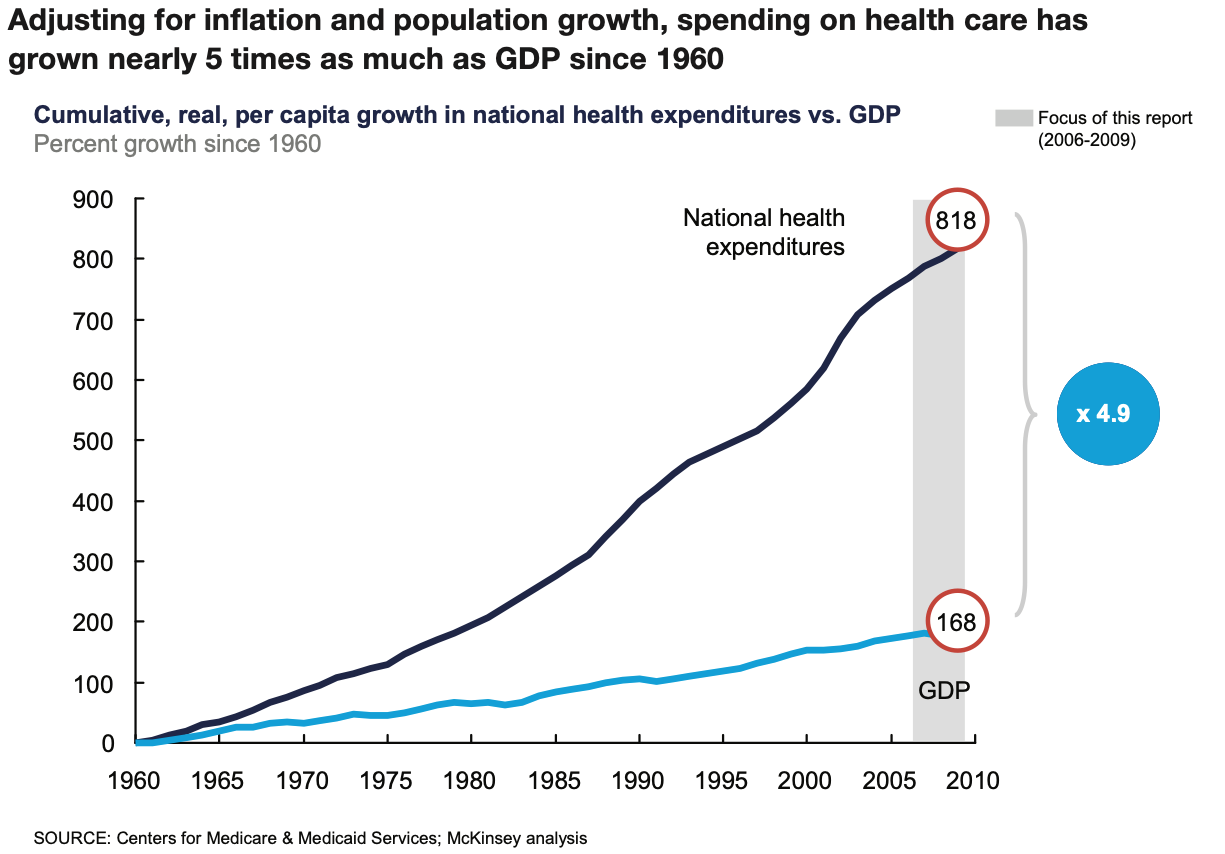To consider if healthcare expenditures are sustainable, one factor to study is the rate of increase in healthcare spending in relation to the rise in economic growth measured by the gross domestic product (GDP).
If the annual increase in health care expenditures continuously outpaces the annual increase in economic growth, the percentage of economic resources that go into health care will increase.
This is the situation we find ourselves in across the world. Let us look at three graphs, looking at present, past, and future spending.
Healthcare spending outpace GDP growth over the last 20 years.

This graph published in a 2015 OECD report (Fiscal Sustainability of Health Systems 2015-Sept-24) demonstrates how health spending has outpaced economic growth. Along the x-axis, we see 34 developed countries. On the y-axis, we see a bar above each country that indicates their average GDP growth rate per capita from 1990 to 2012.
We then see a red diamond, also plotted on the y-axis above each country, indicating the average growth rate in healthcare spending per capita from 1990 to 2012.
The red dot represents the average growth rate per capita in healthcare spending; it is consistently 1% to 3.5% higher than the average GDP growth rate per capita.
In short, the annual rate of health care expenditures continues to rise.
Healthcare spending is anticipated to outpace GDP growth into the future.
A more recent OECD report published in 2019 (Health spending set to outpace GDP growth to 2030, 2019-Nov-07) tries to model the anticipated healthcare expenditures per country as a percentage of GDP between 2015 and 2030.
In 2015 the average OCED country spent 8.8% of their GDP on healthcare. It is modelled that in 2030 the middle OECD country will spend between 9.6% and 10.8% of their GDP on healthcare. This is an increase in health care expenditures as a percentage of GDP somewhere between 0.8% and 2% during 15 years.


The variation in expenditures predicted depends upon the different scenarios created, depending on cost controls and economic productivity.
Let's look at Canada. In 2016 we spent 10.4% of our GDP on healthcare - above the OECD average by 1.6%. It is predicted that by 2030 Canada's healthcare spending will increase to 12.5-13.9% of GDP. This is an increase between 2.1-3.5% over 15 years.

Unsustainable in the long run
Although it is always bad form in economics to extrapolate over long time horizons.
If we do make their error, and take a middle number of a 3% increase in healthcare expenditures in Canada as a percentage of GDP over 15 years and extrapolated out an additional 30 years at the same rate to the year 2060, we would find Canada in a scenario where the percentage of health care expenditures as part of GDP would be around 20%.
To spend 20% of GDP on healthcare seems shockingly high in today's context.
Healthcare expenditures vs GDP since 1960 in the USA

McKinsey compiled in a 2011 report (Accounting for the cost of U.S. health care December 2011) a graph that demonstrates the increase in healthcare spending related to GDP adjusted for inflation and population growth in the USA.
We see along the x-axis years from 1960 to 2010.
Along the y-axis, we see the cumulative, real, per capita percentage growth since 1960 of both national health care expenditures and GDP.
The blue line trends GDP growth over these 50 years and shows how it has risen 168%, per capita, after inflation adjustment.
The much steeper black line demonstrates the growth of national health expenditures during this time and estimates 818% per capita growth since 1960.
The gap between the GDP growth per capita and the national health expenditure growth per capita is a five-fold increase.
Conclusion
There is always debate about the optimal percentage of GDP that countries should spend on healthcare.
However, the graphs above demonstrate that regardless of how much a country spends today, as we continue spending on healthcare faster than GDP growth, we will increase total healthcare spending as a percentage of GDP for the years to come.
One would predict that at some point, this becomes unsustainable and that better models of healthcare are required to help improve health and reduce the burden and expenses of disease.